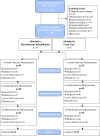Exercise rehabilitation for patients with critical illness: a randomized controlled trial with 12 months of follow-up
- PMID: 23883525
- PMCID: PMC4056792
- DOI: 10.1186/cc12835
Exercise rehabilitation for patients with critical illness: a randomized controlled trial with 12 months of follow-up
Abstract
Introduction: The purpose of this trial was to investigate the effectiveness of an exercise rehabilitation program commencing during ICU admission and continuing into the outpatient setting compared with usual care on physical function and health-related quality of life in ICU survivors.
Methods: We conducted a single-center, assessor-blinded, randomized controlled trial. One hundred and fifty participants were stratified and randomized to receive usual care or intervention if they were in the ICU for 5 days or more and had no permanent neurological insult. The intervention group received intensive exercises in the ICU and the ward and as outpatients. Participants were assessed at recruitment, ICU admission, hospital discharge and at 3-, 6- and 12-month follow-up. Physical function was evaluated using the Six-Minute Walk Test (6MWT) (primary outcome), the Timed Up and Go Test and the Physical Function in ICU Test. Patient-reported outcomes were measured using the Short Form 36 Health Survey, version 2 (SF-36v2) and Assessment of Quality of Life (AQoL) Instrument. Data were analyzed using mixed models.
Results: The a priori enrollment goal was not reached. There were no between-group differences in demographic and hospital data, including acuity and length of acute hospital stay (LOS) (Acute Physiology and Chronic Health Evaluation II score: 21 vs 19; hospital LOS: 20 vs 24 days). No significant differences were found for the primary outcome of 6MWT or any other outcomes at 12 months after ICU discharge. However, exploratory analyses showed the rate of change over time and mean between-group differences in 6MWT from first assessment were greater in the intervention group.
Conclusions: Further research examining the trajectory of improvement with rehabilitation is warranted in this population.
Trial registration: The trial was registered with the Australian New Zealand Clinical Trials Registry ACTRN12605000776606.
Figures


Comment in
-
Critical care rehabilitation trials: the importance of 'usual care'.Crit Care. 2013 Sep 5;17(5):183. doi: 10.1186/cc12884. Crit Care. 2013. PMID: 24103735 Free PMC article.
References
-
- Australia and New Zealand Intensive Care Society. Adult Patient Database. Melbourne: Australia and New Zealand Intensive Care Society; 2007. - PubMed
-
- UK Department of Health. Statistical press notice: monthly critical care beds, cancelled urgent operations and delayed transfers of care data, England: February 2013. [ https://www.gov.uk/government/news/statistical-press-notice-monthly-crit...]
-
- Needham DM, Davidson J, Cohen H, Hopkins RO, Weinert C, Wunsch H, Zawistowski C, Bemis-Dougherty A, Berney SC, Bienvenu OJ, Brady SL, Brodsky MB, Denehy L, Elliott D, Flatley C, Harabin AL, Jones C, Louis D, Meltzer W, Muldoon SR, Palmer JB, Perme C, Robinson M, Schmidt DM, Scruth E, Spill GR, Storey CP, Render M, Votto J, Harvey MA. Improving long-term outcomes after discharge from intensive care unit: Report from a stakeholders’ conference. Crit Care Med. 2012;17:502–509. doi: 10.1097/CCM.0b013e318232da75. - DOI - PubMed
Publication types
MeSH terms
Associated data
LinkOut - more resources
Full Text Sources
Other Literature Sources
Medical
Molecular Biology Databases

